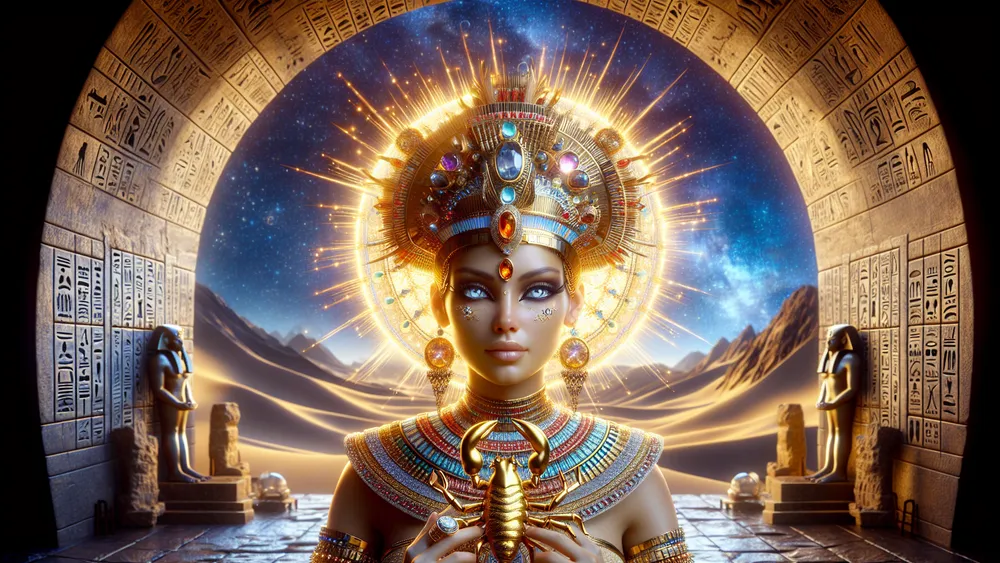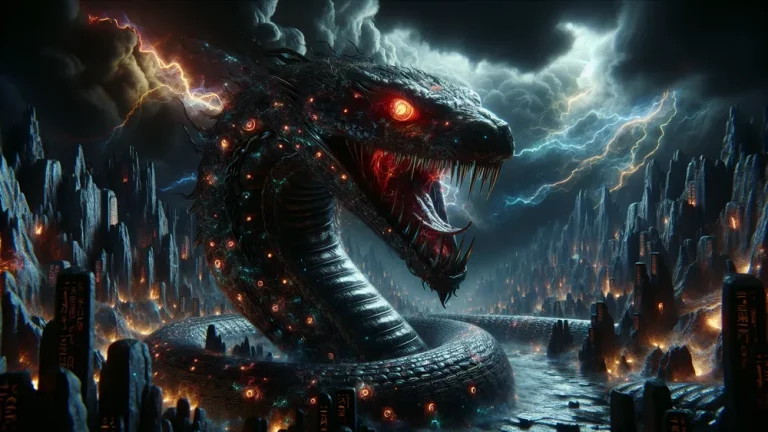Serqet: Egyptian Goddess Of Protection And Healing
Serqet, also called Selket or Selcis, stands out in ancient Egyptian mythology. She’s a goddess of protection and healing. Her name means “She Who Causes the Throat to Breathe,” which shows her link to breath and life. You often see her as a woman with a scorpion on her head. This image highlights her control over venomous creatures and her protective role.
Key Points:
- Serqet is an Egyptian goddess of protection and healing.
- She is linked to breath and life, often represented with a scorpion on her head.
- Serqet has a protective role and is closely connected to other deities like Isis and Neith.
- She controls and heals venomous creatures like scorpions.
- People used Serqet’s name in amulets and rituals for protection and healing.
- Serqet plays a key role in protecting Ra during his underworld night voyage.
- Serqet’s depictions in art and artifacts show her importance in ancient Egyptian culture.
In this blog post, we dive into Serqet’s story. We look at her origins, roles, and how people represented her. From her early ties with scorpions to her key part in the afterlife, Serqet gives us a fascinating glimpse into ancient Egypt’s spiritual world.
The Origins of Serqet
To really get why Serqet matters, we need to look at her early roles and ties in ancient Egyptian religion. So, let’s dive into her first connections and see how she links up with other gods and myths.
Early Role in Egyptian Religion
Serqet’s story starts with her deep connection to scorpions. People in ancient Egypt both feared and respected these creatures for their venomous sting. Early depictions of Serqet show her as a woman with a scorpion on her head, which symbolizes her power over these dangerous animals. Texts from the Old Kingdom period mention her as a protective deity who can ward off venomous bites and stings.
She’s also closely linked with other important deities like Isis, Nephthys, and Neith. In the Osiris myth, she plays a key role in protecting the deceased god Osiris. This highlights her importance in funerary rites and the afterlife. Her ties with these deities show she’s a guardian and healer, crucial to the pantheon of gods who ensure the safety and well-being of both the living and the dead.
- Scorpions in Ancient Egypt: Seen as both protectors and threats.
- Old Kingdom Texts: Earliest mentions of Serqet.
- Isis, Nephthys, and Neith: Deities often linked with Serqet.
- Osiris Myth: Serqet’s protective role in this story.
Serqet, a deity linked with scorpions and other major gods, is crucial for safeguard and healing in both life and death.
Serqet: The Healing Goddess
Now, let’s dive into Serqet’s role as a healing goddess. She really shines when it comes to controlling and healing venomous creatures.
Serqet’s Ability to Control Poisonous Creatures
Serqet is famous for her power over scorpions and other venomous animals. In ancient Egyptian myths, she often commands these dangerous creatures, making sure they don’t harm people. This ability is super important in a society where scorpion stings are common and can be deadly.

But she doesn’t just control them; she’s also known for her healing abilities, especially when it comes to treating venomous stings and bites. People believe that by invoking Serqet through protective amulets and spells, they can cure venom-induced ailments and stay safe from future attacks. These amulets, usually inscribed with her name and symbols, are worn or placed in homes to keep everyone safe.
- Mythological Stories: Tales of Serqet protecting people from scorpion stings.
- Healing Practices: Use of Serqet’s name in medicinal incantations.
- Protective Amulets: Made from materials like gold and faience, often featuring scorpion imagery.
- Cultural Significance: Serqet’s role in daily life and religious practices.
Serqet’s Amulets and Protective Measures
Amulets linked to Serqet come in all sorts of materials like gold, faience, and semi-precious stones. They often show scorpion imagery or have inscriptions that call on Serqet’s powers. People wear these amulets as jewelry or keep them at home to stay safe from venomous creatures.
To make the amulets work, they perform special rituals and prayers, which usually involve reciting spells and making offerings to Serqet. These practices are a big part of ancient Egyptian life, showing just how much they value Serqet’s protection and healing.

| Type of Amulet | Material | Common Symbols/Inscriptions | Usage in Daily Life | Rituals/Prayers |
|---|---|---|---|---|
| Necklace Amulet | Gold | Scorpion imagery, Serqet’s name | Worn for protection | Recitations of spells, offerings to Serqet |
| Home Amulet | Faience | Protective symbols | Placed in homes | Daily prayers, special ceremonies |
| Ring Amulet | Semi-precious stones | Inscriptions invoking Serqet | Worn on fingers | Rituals during illness or danger |
Serqet: Protector of Ra in the Underworld
Besides her healing and protective roles in everyday life, Serqet also has a big part in the cosmic order, especially in the underworld. She’s not just about scorpions and venom; she’s got a whole other side to her.
Serqet’s Guardianship of Ra’s Journey
In ancient Egyptian mythology, Serqet has a key role in protecting the sun god Ra during his night journey through the underworld. She stands guard over Ra’s solar bark, making sure he gets through the night safely. This guardianship is super important because it symbolizes the daily cycle of death and rebirth. Ra’s safe journey means the sun rises each morning.
Serqet works with other protective deities like Isis, Nephthys, and Neith. They form a divine team that defends Ra from all sorts of dangers, especially the serpent Apep. Myths highlight her bravery and smart strategies in these nightly battles, showing how crucial she is in keeping cosmic order.
- Serqet is often depicted alongside other protective deities in tombs and temples.
- Myths describe her using powerful spells to ward off Apep and other threats.
- Her role is celebrated in various religious texts and rituals dedicated to Ra’s night journey.
- Serqet’s guardianship is symbolized in amulets and artifacts found in burial sites.
Serqet’s guardianship over Ra during his night travels symbolizes the cycle of death and rebirth, crucial for the daily sunrise, and she collaborates with other deities to protect him from dangers like the serpent Apep, which emphasizes her importance for maintaining cosmic order.
Serqet’s Battle against the Serpent Apep
In ancient Egyptian mythology, the serpent Apep, also called Apophis, stands for chaos and evil. He’s a huge threat to Ra during his night journey through the underworld. Apep is this giant serpent that tries to swallow Ra’s solar bark, aiming to stop the sun from rising and throw the world into eternal darkness.
Serqet, being a protective deity, steps in to fight this danger. She uses her powers over venomous creatures and her knowledge of powerful spells. Serqet battles fiercely with Apep, using strategies like binding him with magical ropes and stinging him with her deadly stinger.
This fight isn’t just physical; it’s also a symbol of the never-ending struggle between good and evil. Serqet’s victory over Apep ensures that order wins over chaos, reinforcing the ancient Egyptian belief in the cycle of life and the afterlife. Each night symbolizes death, and each dawn represents rebirth.
- Apep is often depicted in ancient texts as a colossal serpent threatening Ra’s journey.
- Serqet’s protective amulets frequently feature symbols of her defeating Apep.
- Rituals invoking Serqet’s power were performed to ensure Ra’s safe passage through the night.
- The battle between Serqet and Apep is a common theme in Egyptian funerary texts and tomb decorations.
Iconography and Representation of Serqet
We’ve talked about Serqet’s roles and powers, but there’s more to her story. Her visual depictions give us a lot of clues about her importance in ancient Egyptian culture. So, let’s dive into how people represented Serqet in different forms of art and artifacts.
Depictions of Serqet as a Woman with a Scorpion Head
In ancient Egyptian art, you often see Serqet as a woman with a scorpion on her head. This shows her control over venomous creatures. Typical features include a human body in traditional Egyptian clothes and a scorpion either on her head or in her headdress. Variations in different periods and regions show slight differences in the style of the scorpion and the details of her clothing.
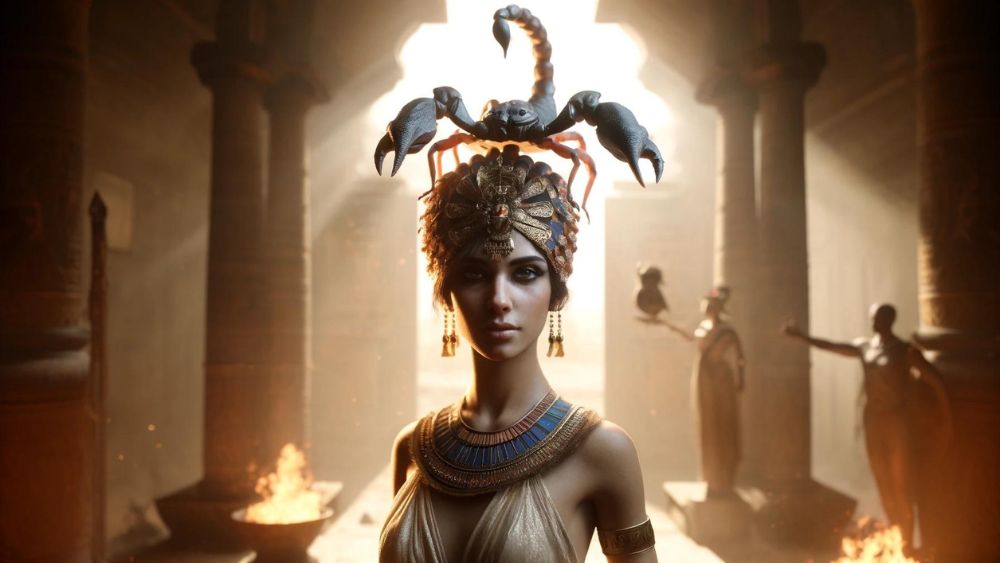
These changes reflect local artistic trends and religious influences. The scorpion head is very symbolic. It represents her power to control and neutralize venom. This fits with her role as a protector and healer. Culturally, this attribute highlights how much the ancient Egyptians respect her ability to protect against and cure poisonous stings and bites.
It shows her importance in both daily life and spiritual practices.
- Early depictions often show Serqet with a more stylized scorpion.
- Later representations may include more detailed and realistic scorpions.
- Artifacts like amulets frequently feature Serqet with a scorpion head for protection.
- Temple reliefs often depict her alongside other protective deities.
Serqet’s representation in ancient Egyptian art with a scorpion on her head symbolizes her power to control and neutralize venom, reflecting local artistic trends and religious influences while emphasizing her role as a protector and healer.
Serqet’s Golden Figure as a Guardian of Tutankhamun
Finding Serqet’s golden figure in Tutankhamun’s tomb is a big deal. This golden artifact shows Serqet with a scorpion on her head, which stands for her protective powers. It was among the treasures in the young pharaoh’s tomb from the 18th Dynasty. Back then, people really believed in divine protection for their kings.
So, in the tomb, Serqet’s job is to keep the pharaoh safe from venomous creatures and other dangers in the afterlife. Her presence there shows how much ancient Egyptians relied on gods and goddesses for protection even after death. The figure’s design and placement highlight her role in warding off evil and ensuring the pharaoh’s well-being.
This practice is crucial in royal burials, showing their trust in deities like Serqet.
- The figure is made from gold, showing its high value.
- Found in Tutankhamun’s tomb, located in the Valley of the Kings.
- Depicts Serqet with a scorpion, a common attribute.
- Reflects 18th Dynasty burial practices, emphasizing divine protection.
- Part of a larger collection of artifacts meant to safeguard the pharaoh in the afterlife.
Serqet’s golden figure in Tutankhamun’s tomb symbolizes ancient Egyptians’ strong belief in divine protection for their kings and underpins the crucial role of deities like Serqet in safeguard and well-being after death.
Gallery: Artistic Representations of Serqet
To get a better feel for Serqet’s importance, let’s dive into the various artistic representations that show off her role and special traits in ancient Egyptian culture.
Paintings of Serqet
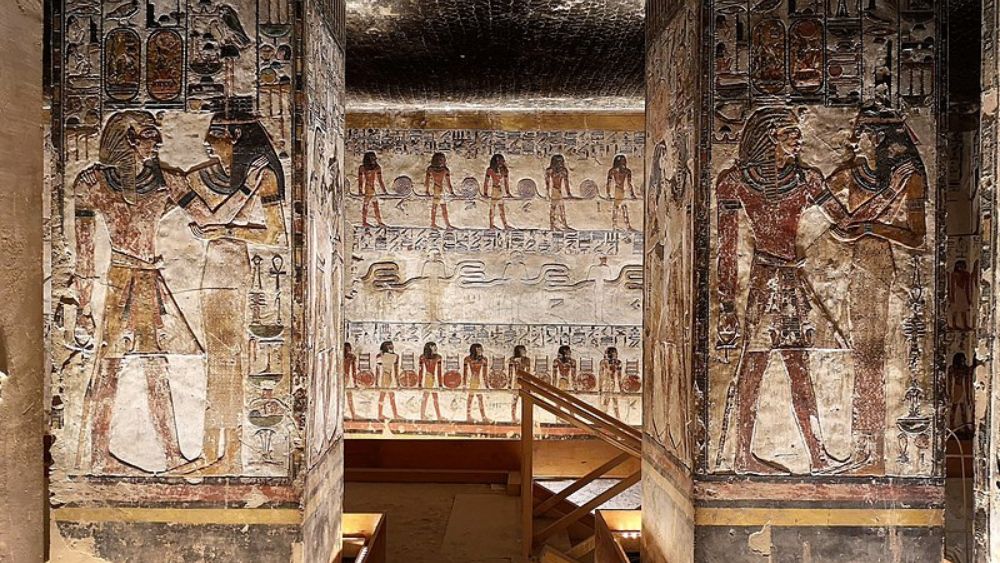
You can find famous paintings and murals of Serqet in many ancient Egyptian tombs and temples. They show how important she is in their religious and cultural practices. For instance, in the tomb of Pharaoh Seti I in the Valley of the Kings, Serqet appears with other protective deities. This highlights her role in protecting the deceased in the afterlife. These paintings use the traditional Egyptian artistic style.
You see profile views of figures, hierarchical proportions, and vivid colors like red, blue, and gold to show divine attributes. The artists use a technique called fresco secco, where they apply pigments to dry plaster. This makes the images detailed and durable. Also, murals in the Temple of Karnak feature Serqet, showing her protective role during Ra’s night journey.
These artistic representations serve a religious function but also give us insight into the symbolism and iconography common in ancient Egyptian art.
- Tomb of Pharaoh Seti I: Location with significant murals of Serqet.
- Traditional Egyptian artistic style: Profile views, hierarchical proportions, vivid colors.
- Fresco secco technique: Method used for durability and detail.
- Temple of Karnak: Another site with important depictions of Serqet.
- Symbolism and iconography: Key elements in understanding ancient Egyptian art.
Reliefs and Hieroglyphics
You often see Serqet in ancient Egyptian reliefs and hieroglyphics, showing off her protective and healing powers. Common themes include her presence alongside other deities in funerary scenes, where she guards the dead or helps them on their journey to the afterlife. You can find these depictions in temples and tombs, serving both religious and protective purposes.
For instance, in the Temple of Edfu, reliefs show Serqet with a scorpion on her head, symbolizing her control over venomous creatures. The hieroglyphics that go with these reliefs often include spells and prayers asking for her protection. The artistic style of these reliefs features detailed carvings with precise lines and symbolic imagery, reflecting the high level of craftsmanship and religious significance attributed to Serqet.
These images not only highlight her divine attributes but also give us a peek into the ritual practices and beliefs of ancient Egyptian society.
- Temple of Edfu: Location with significant reliefs of Serqet.
- Scorpion on her head: Symbolizes her control over venomous creatures.
- Detailed carvings: Reflect high craftsmanship.
- Spells and prayers: Often included in hieroglyphics for protection.
- Funerary contexts: Common scenes where Serqet appears.
Jewelry and Amulets
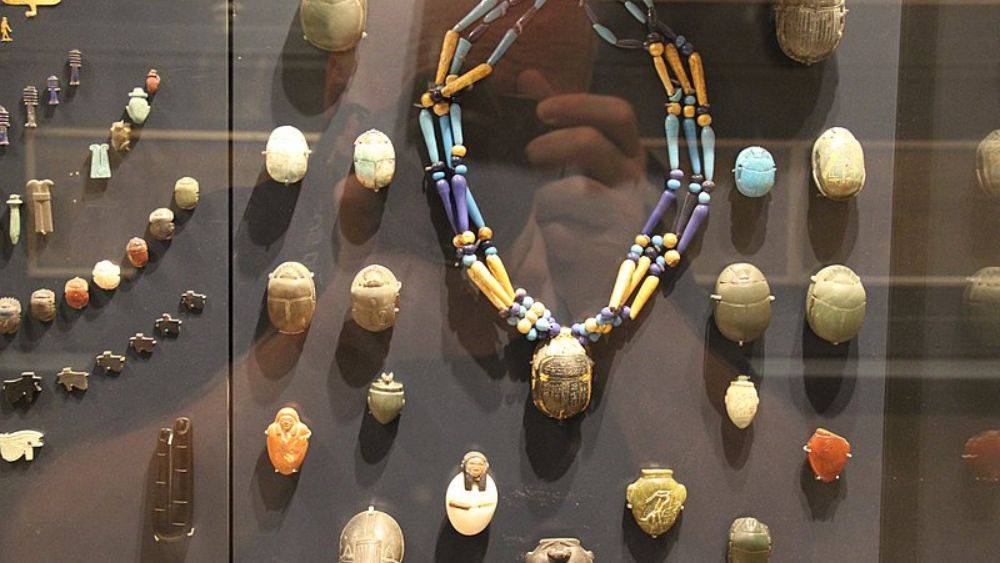
Jewelry and amulets with Serqet’s image come in all sorts of materials like gold, faience, and semi-precious stones. They often show her with a scorpion on her head, which stands for her power over venomous creatures and her protective nature. People wear these amulets to keep safe from scorpion stings and other dangers, and also for general health. The inscriptions on these amulets usually have spells or prayers asking for Serqet’s help.
Besides being worn, these items are also put in tombs to protect the dead in the afterlife. The craftsmanship varies a lot, from simple carvings to really detailed designs, showing the wearer’s social status and how much protection they want.
- Gold and faience: Common materials used in crafting Serqet amulets.
- Scorpion imagery: Represents Serqet’s control over venomous creatures.
- Protective spells: Often inscribed on amulets for added protection.
- Tomb placements: Used to protect the deceased in the afterlife.
- Varied craftsmanship: Ranged from simple to intricate designs.
Jewelry and amulets with Serqet’s image feature scorpion imagery symbolizing her power and are crafted in various materials for protection and health, with inscriptions of spells for extra safety and placed in tombs for afterlife protection, reflecting social status and desired level of defense.
Tutankhamun’s Treasure
In Tutankhamun’s tomb, they find several items related to Serqet, showing just how important she is in ancient Egyptian burial practices. One of the standout pieces is a golden figure of Serqet. It’s intricately crafted and placed right near the young pharaoh’s sarcophagus. This figure, with its detailed engravings, symbolizes her role as a protector in the afterlife. They also discover amulets with Serqet’s image, made from faience and semi-precious stones.
Each one has spells inscribed for protection against venomous creatures. These artifacts highlight not only Serqet’s significance in keeping the dead safe but also reflect the broader cultural and religious beliefs of ancient Egypt. The presence of these items in Tutankhamun’s tomb shows the high level of craftsmanship and the deep spiritual importance attributed to Serqet during this time.
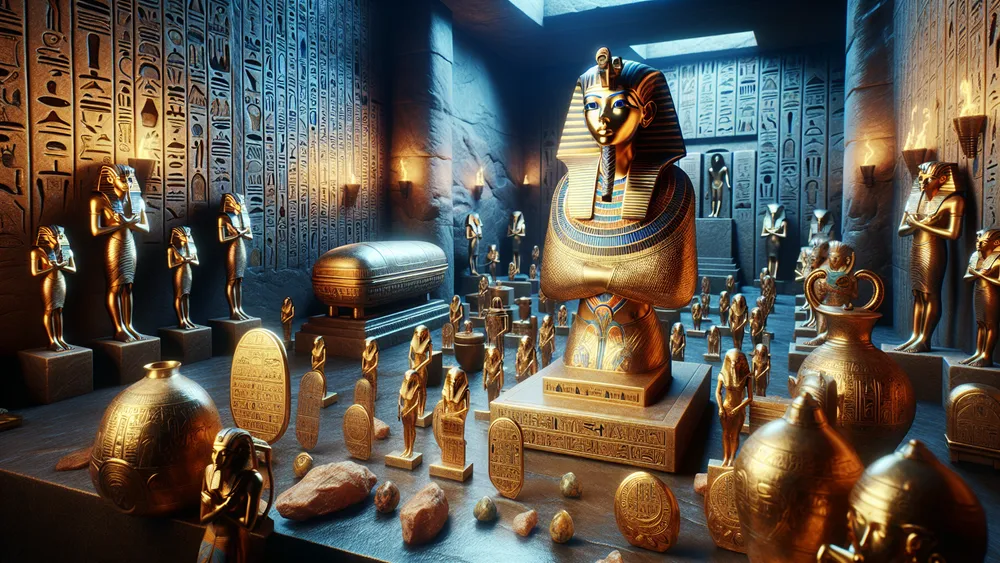
- Golden figure of Serqet: Found near Tutankhamun’s sarcophagus.
- Amulets with Serqet’s image: Made from faience and semi-precious stones.
- Protective spells: Inscribed on amulets for safeguarding the deceased.
- Craftsmanship: Reflects high skill and religious importance.
Pantheon of All the Egyptian Mythology Gods
The Egyptian pantheon? It’s huge and pretty intricate. There are tons of gods and goddesses, each with their own special roles and traits. Want to dive deeper? Check out this list of all the Egyptian gods. It’s packed with details about the main deities, their stories, and why they matter so much in ancient Egyptian culture.
FAQs
1. Who is Serqet in Egyptian mythology?
Serqet in Egyptian mythology is a goddess associated with protection, healing, and the control of venomous creatures.
2. What powers does Serqet have?
The powers Serqet has include control over venomous creatures, healing venomous stings and bites, and providing protection.
3. How was Serqet worshipped in ancient Egypt?
Serqet was worshipped in ancient Egypt through the use of protective amulets, prayers, and rituals invoking her protection and healing powers.
4. What symbols are associated with Serqet?
Symbols associated with Serqet include the scorpion, which represents her protective and healing powers.

